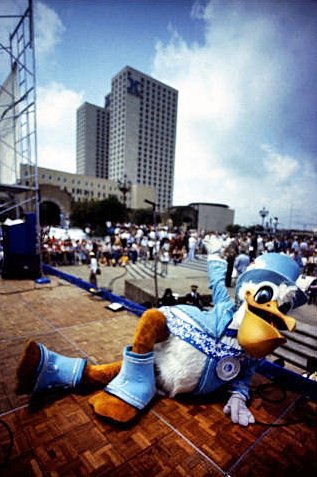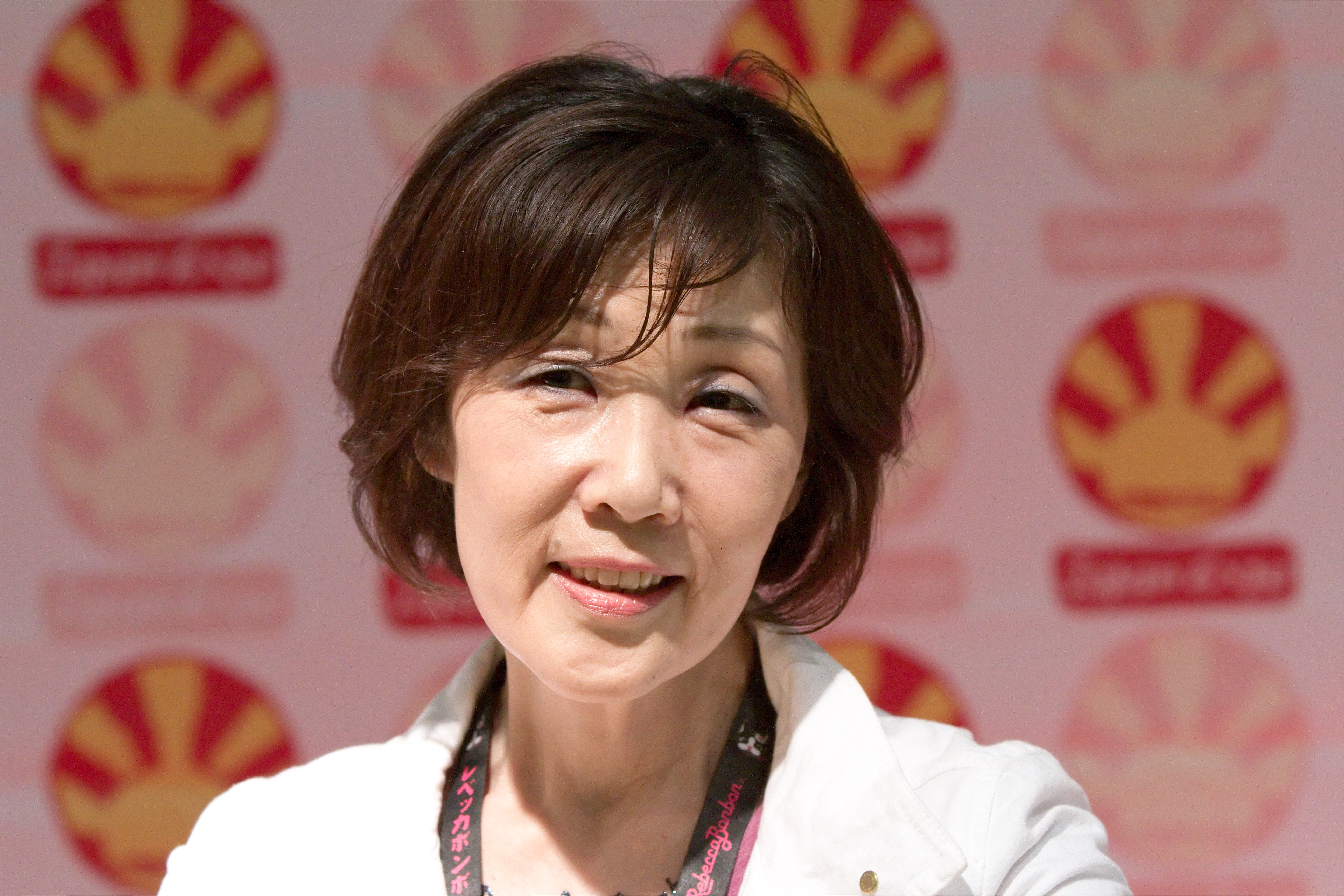|
Choruru
is a mascot character who was created for the 66th annual National Sports Festival of Japan and 11th annual National Sports Festival for People with Disabilities which were held in Yamaguchi prefecture in 2011. After the tournaments, he became head of the Oidemase Yamaguchi Tourism Advertising Department, before becoming the Yamaguchi Prefecture PR General Manager in October 2012. Outline Choruru was first introduced on 14 October 2007 at the 'Oidemase! Yamaguchi Kokutai Jump Up Festa 2007'. His design features green antennae which have the shape of the first kanji character for Yamaguchi (山), which catch the abundant energy of the people and nature. His white face is the shape of the second kanji character for Yamaguchi (口), representing the prefecture's name on his head. The character design was chosen from the 80 entries from a prefecture-wide design contest, with a proposal by Shunan city based design company Sansou Ltd being used. Although the design for Choruru was a ... [...More Info...] [...Related Items...] OR: [Wikipedia] [Google] [Baidu] |
Yuru-chara
is a Japanese term for a category of mascot characters; usually created to promote a place or region, event, organisation or business. They are characterized by their ''kawaii'' (cute) and unsophisticated designs, often incorporating motifs that represent local culture, history or produce. They may be created by local government or other organizations to stimulate tourism and economic development, or created by a company to build on their corporate identity. They may appear as costumed characters (or '' kigurumi'') at promotional events and festivals. ''Yuru-chara'' has become a popular and lucrative business, with character-driven sales reaching nearly $16 billion in Japan in 2012. Popular ''yuru-chara'' include Kumamon, Funassyi, and Chiitan, who have gained international recognition and have reached celebrity status in Japan. Etymology The name ''yuru-chara'' is a contraction of . The adjective generally means "loose", but in this application it has a number of connotati ... [...More Info...] [...Related Items...] OR: [Wikipedia] [Google] [Baidu] |
Yamaguchi Prefecture
is a prefecture of Japan located in the Chūgoku region of Honshu. Yamaguchi Prefecture has a population of 1,377,631 (1 February 2018) and has a geographic area of 6,112 km2 (2,359 sq mi). Yamaguchi Prefecture borders Shimane Prefecture to the north and Hiroshima Prefecture to the northeast. Yamaguchi is the capital and Shimonoseki is the largest city of Yamaguchi Prefecture, with other major cities including Ube, Shūnan, and Iwakuni. Yamaguchi Prefecture is located at the western tip of Honshu with coastlines on the Sea of Japan and Seto Inland Sea, and separated from the island of Kyushu by the Kanmon Straits. History Yamaguchi Prefecture was created by the merger of the provinces of Suō and Nagato. During the rise of the samurai class during the Heian and Kamakura Periods (794–1333), the Ouchi family of Suō Province and the Koto family of Nagato Province gained influence as powerful warrior clans. In the Muromachi period (1336—1573), Ouchi Hiroyo, ... [...More Info...] [...Related Items...] OR: [Wikipedia] [Google] [Baidu] |
Kumamon
Kumamon is a mascot created by the government of Kumamoto Prefecture, Japan. It was created in 2010 for a campaign created to draw tourists to the region after the Kyushu Shinkansen line opened. Kumamon subsequently became nationally popular, and in late 2011, was voted top in a nationwide survey of mascots, collectively known as ''yuru-chara'', garnering over 280,000 votes. Following his success in the contest, Kumamoto earned (, , ) in merchandising revenue for the first half of 2012, after having only earned (, , ) throughout all of 2011. Kumamon enjoys tremendous popularity throughout the world. Economic impact In just two years, Kumamon has generated US$1.2 billion in economic benefits for his region, including tourism and product sales, as well as US$90 million worth of publicity, according to a recent Bank of Japan study. Sales of Kumamon items have reached ¥29.3 billion in 2012, up from ¥2.5 billion in 2011. The Bank of Japan also estimated that Kumamon generated ... [...More Info...] [...Related Items...] OR: [Wikipedia] [Google] [Baidu] |
Hikonyan
is a mascot created by the city government of Hikone, Japan. He was created in 2007 to mark the 400th anniversary of the founding of Hikone Castle. The character design is derived from a legend concerning Ii Naotaka, the 3rd Lord of Hikone. The ''daimyō'' was beckoned by a white cat to seek shelter from a storm in a temple, and thus saved from a lightning strike. In Japanese, "nyan" is an onomatopoeia for a cat's meow. Hikonyan's samurai helmet is based on a Ii family helmet currently in the Hikone Castle museum. Hikonyan's popularity increased tourist visitation of Hikone by over 200,000 annually. The estimate of Hikonyan's effect on the tourist industry is 17.4 billion yen (approximately US$218 million) and the overall economic effects total 33.8 billion yen (US$425 million). Total merchandise sales reached about 1.7 billion yen (US$21 million) as of 2008. In 2010, Hikonyan won first place in the open vote competition of other mascots, collectively known as . See also * ... [...More Info...] [...Related Items...] OR: [Wikipedia] [Google] [Baidu] |
Funassyi
is a fictional Japanese mascot character, unofficially representing the city of Funabashi, Chiba. It was created by a citizen of Funabashi with the objective of cheering up local residents and helping promote her hometown. It has subsequently appeared at events and festivals, as well as on numerous TV programs and commercials, gaining popularity around Japan. The character has also issued 4 CD albums and 6 singles, DVDs, starred in its own anime series and live-action drama special, headlined their own concert at Budokan, and opened its own character goods store. While they remain as an unofficial character, Funassyi is used frequently in official events for Chiba prefecture, the city of Funabashi and Japan herself due to their popularity and high name recognition. Profile Funassyi is neither a girl or a boy but is a fairy. Its parents are ordinary pear trees. Funassyi is the fourth of their 274 children. Its birthday is July 4, and it is 1,883 years old as of 2021 (in a liter ... [...More Info...] [...Related Items...] OR: [Wikipedia] [Google] [Baidu] |
Tokuyama Zoo , a Japanese surname
{{disambiguation ...
Tokuyama (written: 徳山 literally "virtue mountain") may refer to: Locations *Tokuyama Dam, a dam in Gifu Prefecture, Japan *Tokuyama Domain, a Japanese domain of the Edo period *Tokuyama Station, a train station in Yamaguchi Prefecture, Japan *Tokuyama, Yamaguchi, a former city of Yamaguchi Prefecture, Japan *Suruga-Tokuyama Station, a train station Shizuoka Prefecture, Japan Entities *Tokuyama Corporation, a Japanese chemical company *Tokuyama University, a university in Yamaguchi, Japan *Tokuyama Women's College, a junior college in Yamaguchi, Japan Other uses *Tokuyama (surname) Tokuyama (written: 徳山, lit. "mountain of virtue") is a Japanese surname. Notable people with the surname include: *, Japanese actor and singer *, born Chang-Soo Hong, South Korean boxer *, Japanese samurai *, Japanese singer {{surname, Tokuyam ... [...More Info...] [...Related Items...] OR: [Wikipedia] [Google] [Baidu] |
Male Characters In Advertising
Male (symbol: ♂) is the sex of an organism that produces the gamete (sex cell) known as sperm, which fuses with the larger female gamete, or ovum, in the process of fertilization. A male organism cannot reproduce sexually without access to at least one ovum from a female, but some organisms can reproduce both sexually and asexually. Most male mammals, including male humans, have a Y chromosome, which codes for the production of larger amounts of testosterone to develop male reproductive organs. Not all species share a common sex-determination system. In most animals, including humans, sex is determined genetically; however, species such as '' Cymothoa exigua'' change sex depending on the number of females present in the vicinity. In humans, the word ''male'' can also be used to refer to gender in the social sense of gender role or gender identity. Overview The existence of separate sexes has evolved independently at different times and in different lineages, an examp ... [...More Info...] [...Related Items...] OR: [Wikipedia] [Google] [Baidu] |
Costumed Character
A costumed performer or suit performer wears a costume that usually, (but not always) covers the performer's face, typically to represent a non-human character such as a mascot or cartoon character. These range from theme park "walk-around" or "meetable" characters, the mascots of corporations, schools, or sports teams to novelty act performers. Some costumes cover the performer's face especially those in theme parks. Examples include sports mascots and performances as fantasy characters on children's television and in theme parks. Problems in suit performance include intense physical exertion, claustrophobia and hyperthermia. In theme parks, international fairs, and festivals Costumed performers are a major feature of amusement parks like Walt Disney Parks and Resorts, Universal Parks & Resorts, Sesame Place, Legoland, SeaWorld, Hershey Park, Six Flags, and Nickelodeon Universe, as well as many other large or small theme parks and fairs. Costumed performers are intended t ... [...More Info...] [...Related Items...] OR: [Wikipedia] [Google] [Baidu] |
Sanrio
is a Japanese entertainment company. It designs, licenses, and produces products focusing on the '' kawaii'' ("cute") segment of Japanese popular culture. Their products include stationery, school supplies, gifts, and accessories which are sold worldwide, including at specialty brand retail stores in Japan. Sanrio's best-known character is Hello Kitty, a little cartoon girl cat and one of the most successful marketing brands in the world. Besides selling character goods, Sanrio takes part in film production and publishing. They own the rights to the '' Mr. Men'' characters and Japanese licensing rights to the ''Peanuts'' characters. Their animatronics branch, called Kokoro Company, Ltd. (''kokoro'' being Japanese for 'heart') is best known for the Actroid android. The company also runs a franchise of KFC in Saitama Prefecture. History Shintaro Tsuji founded Sanrio on August 10, 1960, then known as the Yamanashi Silk Company using in capital. In 1962, Tsuji expanded his ente ... [...More Info...] [...Related Items...] OR: [Wikipedia] [Google] [Baidu] |
Sanrio Puroland
, also known as ''Hello Kitty Land'', is an indoor theme park located in Tama New Town, Tokyo, Japan. Opened on December 7, 1990, it hosts attractions, live shows, shopping outlets, and restaurants dedicated to Sanrio characters such as Hello Kitty, My Melody, Cinnamoroll, Gudetama, and Aggretsuko, in a manner akin to Disney theme parks. Sanrio Puroland attracts over 1.5 million visitors per year, and is ranked among the major theme parks in Japan, along with both Tokyo Disney Resort parks and Fuji-Q Highland. Sanrio also operates Harmonyland, an outdoor theme park in Oita Prefecture. History Origins During its conceptual phase, Sanrio Puroland was known by many names - first as Sanrio Communication World, as well as Sanrio Heart Park and Sanrio Piero Land. The original theme was going to be "communication", as opposed to Sanrio's existing works, including its characters. Sanrio Puroland was a "bald attempt" to challenge the Walt Disney company and its theme parks. To bui ... [...More Info...] [...Related Items...] OR: [Wikipedia] [Google] [Baidu] |
Hello Kitty
, also known by her full name , is a fictional character created by Yuko Shimizu, currently designed by Yuko Yamaguchi, and owned by the Japanese company Sanrio. Sanrio depicts Hello Kitty as an anthropomorphized white cat with a red bow and no visible mouth. According to her backstory, she lives in a London suburb with her family, and is close to her twin sister Mimmy, who is depicted with a yellow bow. Hello Kitty was created in 1974 and the first item, a vinyl coin purse, was introduced in 1975. Originally Hello Kitty was only marketed towards pre-teenage girls, but beginning in the 1990s, the brand found commercial success among teenage and adult consumers as well. Hello Kitty's popularity also grew with the emergence of '' kawaii'' (cute) culture. The brand went into decline in Japan after the 1990s, but continued to grow in the international market. By 2010 the character was worth a year and ''The New York Times'' called her a "global marketing phenomenon". By 2014, wh ... [...More Info...] [...Related Items...] OR: [Wikipedia] [Google] [Baidu] |



